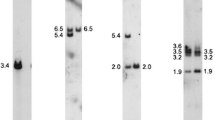Abstract
All three species of Notomys so far studied possess a diploid number of 48. Many elements in the karyotype of N. alexis are polymorphic due to variation in heterochromatin, but the variation is most marked in autosomal pair 1, which occurs in at least four forms, the X-chromosome, which occurs in three forms, and the Y-chromosome which occurs in many forms. N. cervinus is unique in the genus in possessing an entirely biarmed karyotype due mainly to the addition of heterochromatic short arms. The X-chromosome of N. cervinus occurs in three forms and the Y-chromosome in two forms. The karyotype of N. fuscus is mainly telocentric although two autosomal pairs are polymorphic due to pericentric inversions. The X- and Y-chromosomes both occur in two forms in N. fuscus. Chromosome measurements and C-banding show that most of the variation in the size and morphology of the sex-pair both within and between species is due to variation in constitutive heterochromatin.
Similar content being viewed by others
References
Arrighi, F.E., Hsu, T.C.: Localization of heterochromatin in human chromosomes. Cytogenetics 10, 81–86 (1971)
Baverstock, P.R., Hogarth, J.T., Cole, S., Covacevich, J.: Biochemical and karyotypic evidence for the specific status of the rodent Leggadina lakedownensis Watts. Trans. roy. Soc. S. Aust. 100, 109–112 (1976)
Baverstock, P.R., Watts, C.H.S., Hogarth, J.T.: Chromosome studies of Australian rodents. I. The Pseudomyinae, Hydromyinae, and Uromys/Melomys. Chromosoma (Berl.) 61, 95–125 (1977)
Bianchi, N.O., Contreras, J.R.: The chromosome of the field mouse Akodon azarae (Cricetidae, Rodentia) with special reference to sex chromosome anomalies. Cytogenetics 6, 306–313 (1967)
Bradshaw, W.N., Hsu, T.C.: Chromosome of Peromyscus (Rodentia, Cricetidae). III. Polymorphism in Peromyscus maniculatus. Cytogenetics 11, 436–451 (1972)
Fredga, K.: Unusual sex chromosome inheritance in mammals. Phil. Trans. roy. Soc. Lond. B 259, 15–36 (1970)
Fredga, K., Mandahl, N.: Autosomal heterochromatin in some Carnivores. In: Chromosome identification. Nobel Symp. 23, 104–117 (1973)
Mukherjee, B.B., Milet, R.G.: Nonrandom X-chromosome inactivation — an artifact of cell selection. Proc. nat. Acad. Sci. (Wash.) 69, 37–39 (1972)
Newsome, A.E., Corbett, L.K.: Outbreaks of rodents in semi-arid and arid Australia: causes, preventions, and evolutionary considerations. In: Rodents in desert environments (I. Prakash and P.K. Ghosh, eds.). The Hague: Dr. W. Junk D.V. 1975
Ohno, S., Beçak, W., Beçak, M.L.: X-autosome ratio and the behaviour pattern of individual X-chromosomes in placental mammals. Chromosoma (Berl.) 15, 14–30 (1964)
Rao, S.R.V., Shah, V.C., Seshadri, C.: Studies on rodent chromosomes. II. Autoradiographic study of the sex chromosomes of the Indian gerbil, Tatera indica cuverii (Waterhouse) and its bearing on the Lyon Hypothesis. Chromosoma (Berl.) 23, 309–316 (1968)
Reig, O.A., Olivo, N., Kiblisky, P.: The idiogram of the Venezuelan vole mouse, Akodon urichi venezuelensis Alien (Rodentia, Cricetidae). Cytogenetics 10, 99–114 (1971)
Schmid, W.: Heterochromatin in mammals. Arch. Klaus-Stift. Vererb.-Forsch. 42, 1–60 (1967)
Sharma, T., Raman, R.: Variation of constitutive heterochromatin in the sex chromosomes of the rodent Bandicota bengalensis bengalensis (Gray). Chromosoma (Berl.) 41, 75–84 (1973)
Simpson, G.G.: Zoogeography of Australian mammals. Evolution (Lawrence, Kans.) 15, 431–446 (1961)
Tate, G.H.H.: Rodents of Australia and New Guinea. Results of Archbold Expedition. 65. Bull. Amer. Mus. Nat. Hist. 97, 183–430 (1951)
Watts, C.H.S.: The Australian rodents Notomys alexis and Pseudomys australis as laboratory animals. I.C.L.A. Asian Pacific Meeting on Laboratory Animals. Experimental Animals 22, 179–185 (1973)
Yong, H.: Geographic variation in the sex chromosomes of the West Malaysian house shrew Suncus murinus (Insectivora, Soricidae). Caryologia (Firenze) 27, 65–71 (1974)
Author information
Authors and Affiliations
Rights and permissions
About this article
Cite this article
Baverstock, P.R., Watts, C.H.S. & Hogarth, J.T. Polymorphism of the X-chromosome, Y-chromosome and autosomes in the Australian hopping mice, Notomys alexis, N. cervinus and N. fuscus (Rodentia, Muridae). Chromosoma 61, 243–256 (1977). https://doi.org/10.1007/BF00292808
Received:
Accepted:
Issue Date:
DOI: https://doi.org/10.1007/BF00292808



